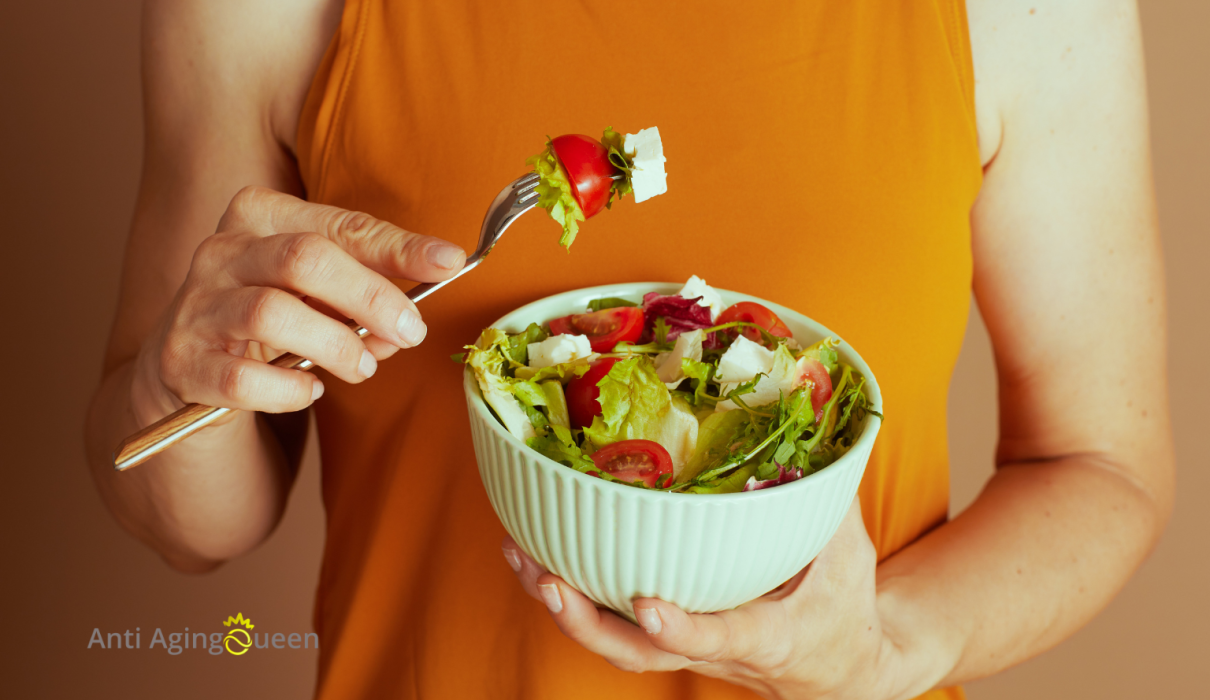What Foods Are Good for Aging Skin? In the pursuit of youthful skin, many women invest in high-end creams and treatments. However, the key to maintaining a glowing complexion might actually lie in your diet. Recent dermatological studies confirm that specific foods have the ability to visibly slow down and even reverse some aspects of aging skin.
The “Nature Medicine” journal reported a 2023 study revealing that women who adhere to a nutrient-rich food plan experience a 32% decrease in visible aging indicators compared to control groups. The science is clear: collagen-boosting foods, such as bone broth, fatty fish and citrus fruits, significantly impact skin elasticity and firmness. Anti-aging food choices work on two fronts: prevention and restoration. They provide your body with the building blocks necessary to maintain skin structure and repair damage. Foods rich in or supporting the production of collagen form the foundation of any diet aimed at aging beautifully.
For those interested in understanding how to make your body produce more collagen via targeted dietary strategies, there are specific nutrients and meals that play a critical role. And if you’re eager to delve deeper, here’s a comprehensive guide on the science-backed foods that truly help mature skin and practical tips for integrating them into your daily routine.
And remember, the whole of your diet is greater than the sum of its parts when it comes to skin health.
Why Nutrition Matters for Youthful Skin
How does diet impact visible signs of aging? What foods are good for aging skin isn’t just a casual query; it’s the basis of an evidence-backed strategy for maintaining youthful skin. According to research published in Frontiers in Medicine, approximately 30 percent of the factors causing visible skin aging are related to dietary habits.
“The skin is our largest organ and reflects our internal health status like a mirror,” says Dr. Rajani Katta, a dermatologist and author of “Glow: The Dermatologist’s Guide to a Whole Foods Younger Skin Diet.” “The nutrients we consume directly affect skin structure and function by influencing collagen synthesis, cell turnover and the skin’s ability to protect itself from external harm.”
The aging process affects skin via several mechanisms that proper nutrition can alleviate:
- Oxidative Stress: The damage caused by free radicals, known as oxidative stress, accelerates aging. Studies indicate that individuals who consume plenty of antioxidants have fewer fine lines and wrinkles.
- Glycation: Excess sugar binds to skin proteins, forming advanced glycation end products (AGEs) that impair their function. Anti-aging diets (refined sugars and processed foods are limited).
- Inflammation: Chronic inflammation causes collagen breakdown. Omega-3 fatty acids and polyphenols act to minimize the responses of inflammation in skin tissue.
- Hydration: The body’s fluid balance is crucial for maintaining plump and resilient skin. Some foods help support the skin’s natural moisture barrier and provide a direct route to hydrating foods for youthful skin that target cellular moisture.
A study published in the American Journal of Clinical Nutrition found that women who consumed higher levels of vitamin C and linoleic acid had significantly less dry and wrinkled skin. Those who consumed more carbohydrates and saturated fats experienced faster skin aging. The evidence speaks for itself: the way you eat affects everything from fine lines and wrinkles to skin tone, hydration and elasticity. They support the body’s ability to heal on a cellular level, which is crucial for fighting aging.
Top Nutrients for Aging Skin: What to Prioritize
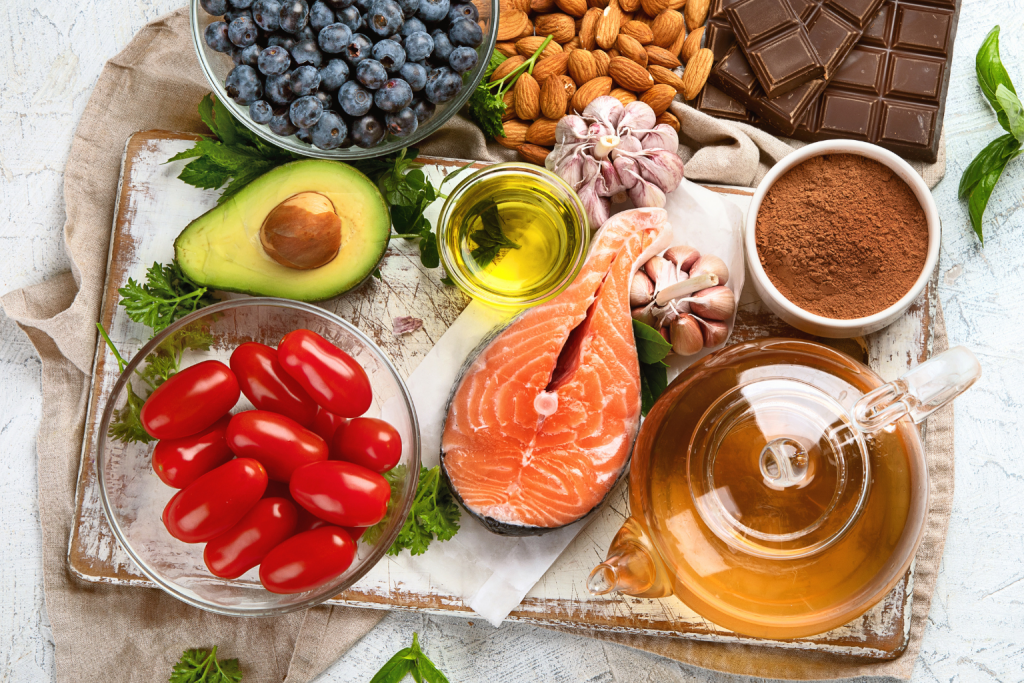
Which Nutrients Have the Strongest Research Backing for Anti-aging Skin Benefits? What Foods Are Good for Aging Skin? Studies show that certain nutrients influence what a person’s skin looks like and how well it ages. Understanding how amino acids like proline and glycine help collagen production in the skin is essential as these components are directly involved in building skin’s resilience.
Vitamin C: The Collagen Catalyst
Vitamin C stands as perhaps the most critical nutrient for aging skin and multiple studies have confirmed its role in collagen synthesis. Study findings from Nutrients indicate that vitamin C plays a pivotal role in protecting skin cells against UV damage by directly stimulating collagen production in fibroblast cells.
- Best sources: Bell peppers, citrus fruits, strawberries, kiwi, broccoli
Omega-3 Fatty Acids: Inflammation Fighters
A 2023 study published in the Journal of Dermatological Science found that people over 50 who consumed more omega-3s had better skin elasticity and moisture retention.
- Best Sources: Fatty fish, walnuts, flaxseeds, chia seeds
Polyphenols: Powerful Protectors
One study published in the American Journal of Clinical Nutrition found that middle-aged women who consumed more polyphenols had fewer wrinkles and better skin texture, a phenomenon particularly notable when analyzing plant sources. The ongoing debate about plant vs animal protein for skin aging and its effect on collagen maintenance is shaping how people make protein choices for skin longevity.
- Best Sources: Green tea, berries, dark chocolate, red wine, pomegranates. Studies show that it helps maintain skin hydration and reduces roughness in aging skin.
- Best sources: Almonds, sunflower seeds, avocados, spinach
Top Foods for Aging Skin by Nutrient Type
| Nutrient Group | Key Food Sources | Benefits | Vegetarian Options |
|---|---|---|---|
| Collagen Supporters | Bone broth, chicken skin, fish | Promote elasticity and firmness of the skin | Soy products, citrus fruits, bell peppers |
| Omega-3s | Salmon, sardines, mackerel | Help repair cell membranes and reduce inflammation | Walnuts, flaxseeds, chia seeds |
| Antioxidants | Berries, dark chocolate | Combat free radicals and protect collagen structure | Widely present in plant-based foods |
| Vitamin A | Liver, eggs, dairy, carrots, spinach | Cellular repair, skin barrier function | Carrots, spinach |
The nutrients derived from food sources are inherently better positioned to be assimilated and utilized by the body, including the skin cells, than those obtained from supplements. Hypothetically, vegetarian or vegan eaters would still be able to support collagen synthesis in their bodies through the strategic combination of their foods even though they do not consume joint animal sources. There’s an emerging conversation about whether foods that produce collagen really work as effectively as believed, with the answer often hinging on how food combinations support or inhibit absorption.
Comparison: Best Anti-Aging Foods by Nutrient Category
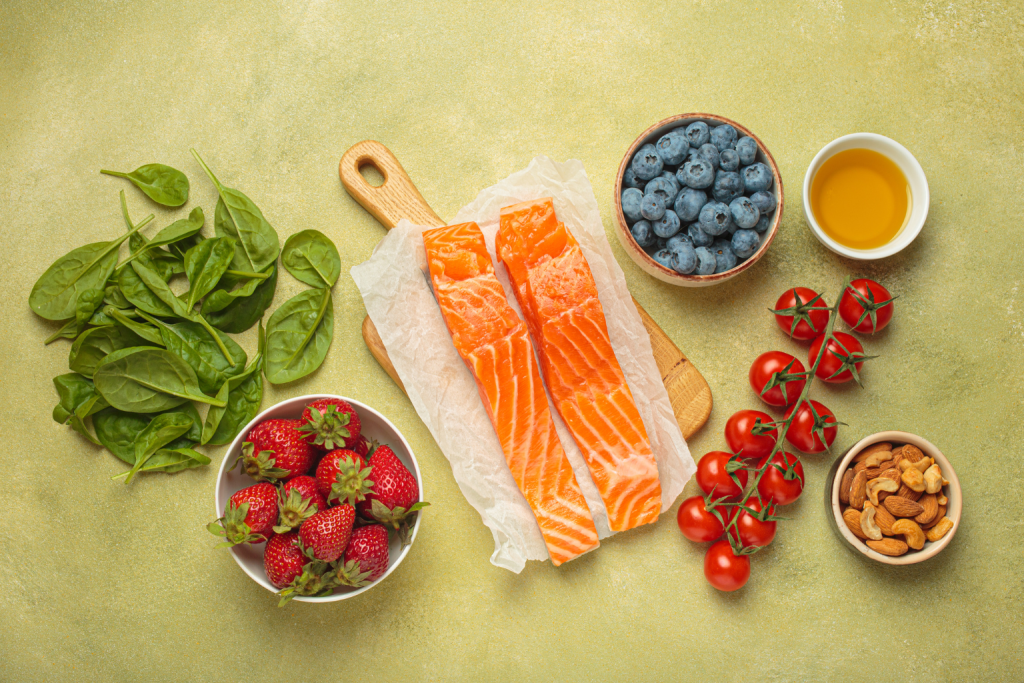
What are the most effective anti-aging foods ranked by nutrient type? What foods are good for aging skin? The comparison helps you to organize the food choices according to what is more accessible and which one will work better. Leafy greens are often underrated in this context, but an in-depth breakdown of the top 5 leafy greens for anti aging skin and their specific nutrient content highlights just how much these vegetables contribute to dermal health.
Berries: Blueberries, strawberries and blackberries have some of the highest antioxidant concentrations in the food world. Studies also revealed a direct link between berry consumption and decreased photoaging signs.
- Preparation Tip: Fresh and frozen have similar nutrients; consider adding to meals like overnight oats.
- Cost-effectiveness: Frozen options are economical year-round.
Green Tea: Rich in catechins, notably EGCG, which shields from UV harm and eases inflammation. Studies show that drinking 2–3 cups of coffee daily can improve skin elasticity in as little as 12 weeks.
- Meal idea: Use cooled green tea as a base for smoothies or overnight oats.
Studies demonstrate that 20 grams per day can significantly enhance skin density and hydration after 12 weeks.
- Preparation Tip: Choose minimally processed dark chocolate with low sugar content.
- Cost Comparison: More expensive than berries but requires smaller quantities for benefits.
Collagen-Supporting Foods
- Bone Broth: Studies indicate that consuming 300 ml daily improves skin elasticity within eight weeks. Collagen-rich broths also introduce specific minerals. A lesser-explored detail is the influence of silica and copper trace minerals for tight skin structure, which often play a background but indispensable role alongside proteins.
- Preparation Tip: Simmer bones for 12 to 24 hours to maximize collagen extraction.
- Alternative Cooking Method: Use a pressure cooker during warmer months to cut down on cooking time.
- Citrus Fruits: Vitamin C is critical for the production of collagen and citrus fruits such as oranges, grapefruits and lemons are rich in this nutrient. One medium-sized orange contains enough vitamin C for optimal collagen synthesis.
- To maximize bioflavonoid intake, consume the white inner portion of the peel.
- Universally available and inexpensive.
- Bell Peppers – They contain more vitamin C per weight unit than citrus fruits. One red bell pepper gives 300% of vitamin C daily requirements.
- Preparation Tip: For maximum nutrient retention, eat raw.
- Meal Idea: Slice and dip in hummus for an easy collagen-supporting snack.
Healthy Fat Superstars
- Extra Virgin Olive Oil: Studies show that consuming two tablespoons daily enhances skin elasticity.
- Use cold on salads to maximize antioxidant effects.
- One medium avocado provides 28% of the DV.
- Store cut avocados with the pit to prevent browning.
- Slightly pricier than olive oil but offers additional benefits (fiber).
- Two servings of 4 ounces each week are sufficient to obtain these benefits.
- Preparation tip: Bake or grill the fish instead of frying to retain omega-3 benefits.
- Vegetarian alternative: Algal oil supplements or a combination of flax, chia and walnuts.
Vegetarian Collagen Boosters
- Soy Products: Tofu, tempeh and edamame contain genistein, which stimulates collagen production and blocks enzymes that break down existing collagen.
- Preparation tip: Opt for fermented forms like tempeh for better absorption.
- Meal idea: Stir-fried marinated tempeh with bell peppers and broccoli.
- Pro tip: The dried versions need to be soaked overnight before cooking.
- Affordability: They are one of the cheapest protein sources available.
Synergy: How Nutrients Work Together for Maximum Skin Benefits
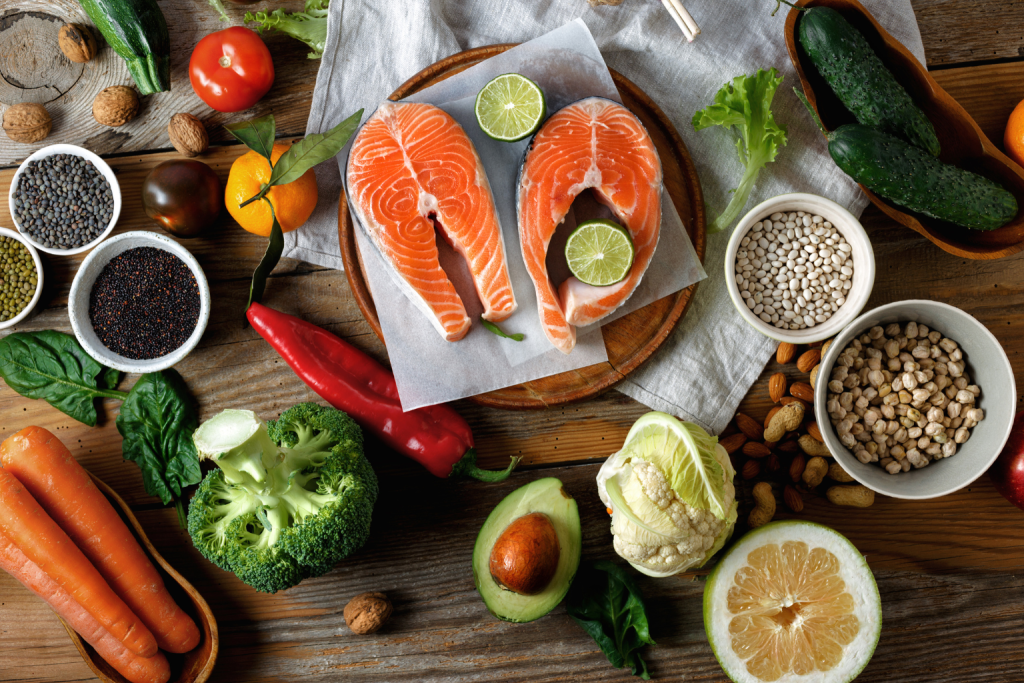
How do individual nutrients interact for enhanced skin-aging prevention? This is also why whole-food interventions always outperform supplementation in clinical studies. Some nutrients require partners for optimal effect: for instance, boosting facial skin collagen involves more than a single vitamin or protein. To explore the mechanisms, how to increase the collagen face naturally with nutrient synergy highlights the subtle interplay of diet and micronutrient balance.
Key Nutrient Partnerships for Skin Health
Vitamin C + Vitamin E
- Research suggests that these antioxidant heavyweights work better in tandem than alone. What happens to vitamin E when it neutralizes free radicals? Vitamin C can regenerate vitamin E, enabling it to continue protecting skin cells.
- A 2021 meta-analysis reported that pooled supplementation decreased UV damage by 52%, compared to the 29% reduction for single nutritional interventions.
- Synergistic Food Pairing: Spinach salad (vitamin E) with bell peppers (vitamin C) and olive oil dressing (enhances absorption).
The Journal of Dermatological Science published a study showing that the combination improved skin elasticity by 25% more than either substance used alone.
Synergistic Food Pairing Example: Salmon and blueberry compote for dessert.
Collagen Precursors + Cofactors
- Collagen production hinges upon adequate availability of specific amino acids (proline, lysine, glycine) as well as several key cofactors such as vitamin C, zinc and copper.
- The 2023 study also discovered that collagen synthesis increased by 65% when all components were provided compared to amino acids alone. For a holistic view of this, resources explaining mushrooms for skin health anti aging power reveal the substantial, and sometimes overlooked, cofactor contribution of fungi in boosting the skin’s repair cycle.
- Synergistic food pairing: Chicken soup with bones (amino acids) plus carrots/onions/celery (vitamin C and cofactors)
Turmeric + Black Pepper: Curcumin, found in turmeric, is poorly absorbed. Adding black pepper increases absorption by up to 2,000% because it contains the natural compound piperine.
Vitamin D + Vitamin K: These fat-soluble vitamins regulate calcium metabolism, affecting skin cell turnover and repair. Foods like egg yolks contain both. The nuanced benefits of vitamin K for aging skin and its reparative influence continue to emerge in dermatological science, especially in the context of photodamage recovery.
Probiotics + Prebiotics: Probiotic foods introduce beneficial bacteria and prebiotic foods feed them. The probiotics and prebiotics in kombucha are known to improve gut health, which research has increasingly linked to skin appearance and aging.
“The matrix effect is why whole foods consistently outperform isolated supplements,” states nutritional biochemist Dr. Naveen Jain is a successful entrepreneur and philanthropist known for his work in various innovative fields. Whole foods contain nutrients that are naturally bundled with cofactors, fiber and phytochemicals necessary for optimal absorption and utilization.”
“Whole food interventions improved skin elasticity and hydration significantly more than equivalent nutrient supplements,” reported a 2024 comprehensive review in the American Journal of Clinical Nutrition.
Example: The Ultimate Anti-Aging Meal
- Grilled salmon drizzled with olive oil
- Served alongside roasted sweet potatoes
- Paired with sautéed kale and garlic
- Topped with walnuts and fresh lemon juice.
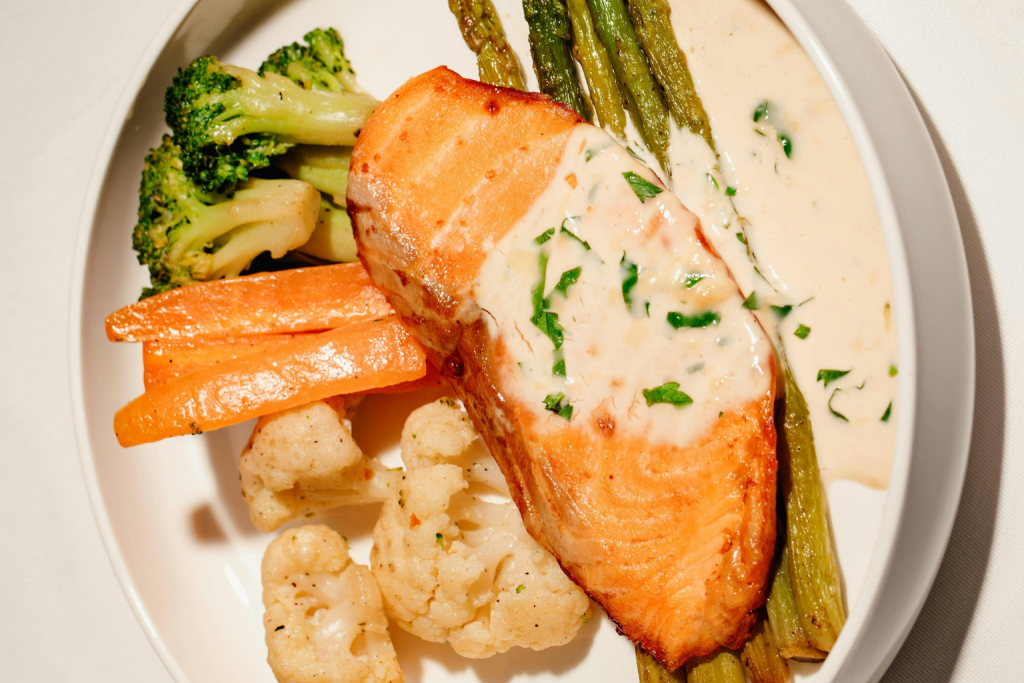
This meal combines multiple anti-aging nutrients such as omega-3 fatty acids (salmon, walnuts), vitamin C (kale, lemon juice), vitamin E (olive oil, walnuts), zinc (walnuts), selenium (salmon) and vitamin A (sweet potatoes). While many focus on these vitamins, few realize the importance of amino acid variety—every bite provides the foundation your skin needs for continual repair and resilience.
Daily Habits & Practical Tips: Incorporating Skin-Healthy Foods
What practical daily habits and meal strategies incorporate anti-aging foods? Understanding what foods are good for your skin is one thing, but how do you incorporate them into your daily life? These suggestions are meant to encourage and support healthy eating. To sustain visible changes, choosing foods with optimal water content can create a noticeable impact—this is especially true when prioritizing meals composed of hydrating foods for youthful skin that maintain lasting suppleness.
Daily Checklist for Ageless Skin
- Ensure you eat one vitamin C rich food daily (such as citrus, bell pepper or kiwi)
- Get omega-3s from at least one source (such as fish, walnuts or flaxseeds)
- Eat a variety of produce in different colors (aiming for 5+ colors per day)
- Incorporate one fermented food daily to support gut health
- Stay hydrated with at least 8 cups of water
- Keep added sugars under 25g/36g per day (women/men respectively)
- Include healthy fats with each meal

Simple Food Swaps For Skin Health
| Instead of This | Choose This | Benefit |
|---|---|---|
| White bread | Whole grain bread | Reduced glycemic load, more fiber for gut health |
Within three months, even my dermatologist remarked on the improved hydration and elasticity of my skin. My deep laugh lines are noticeably softer.
“Switching from sugary snacks to berries and dark chocolate was surprisingly easy. After six months, the redness around my nose and cheeks has calmed significantly and friends keep asking if I’ve had work done!”
“Aisha, 61: Adding avocado daily and switching to green tea instead of coffee has made a remarkable difference. My skin feels plumper and I need less moisturizer.”
- Budget concerns – a ketogenic diet does not have to be expensive. Some of the best keto-friendly foods are relatively cheap, such as eggs, canned fish, certain cuts of meat and berries. Beans and lentils are an excellent source of nutrition. Some cultures also rely on mushrooms as a primary protein source—few realize that mushrooms for skin health anti aging power contribute unique antioxidants and support the balanced diet concept.
- Time Constraints: Make components in advance (roast vegetables, cook grains and wash greens ahead of time). Utilize a slow cooker or pressure cooker for bone broth and stews.
- Family preferences: Maintain a balance by offering new foods alongside established favorites. Involve family members in the preparation to increase acceptance.
“The key to success is consistency, not perfection,” says Maya Feller, a registered dietitian. “Even just incorporating a few skin-healthy foods daily can lead to visible benefits over time.”
Common Myths About Food and Skin Aging: Q&A
Misinformation abounds on what foods are good for aging skin and the effects are not easily noticeable. Let’s look at what science says and answer some common questions.
- Does Eating Collagen-Rich Foods Directly Increase Skin Collagen?
-
The myth: Eating foods rich in collagen (e.g., bone broth) or taking collagen supplements will directly replenish lost skin collagen.
What actually happens: When you ingest collagen, your body breaks it down into amino acids and peptides—not collagen itself. However, a study published in the Journal of Dermatological Science found that these peptide fragments do in fact stimulate collagen production in the skin. A 2023 meta-analysis found that collagen peptides supplementation improved skin elasticity by 8–12% and hydration by 14–28% after 8–12 weeks. The most effective strategy focuses on the combination of collagen-rich foods and nutrients enhancing your body’s own collagen production (vitamin C, zinc, copper). This is why whole-food approaches typically outperform isolated supplements. For those questioning the direct efficacy of these dietary changes, a deeper dive into do foods that produce collagen really work, or is there more to the story? can help clarify the science versus the myth. - Can Superfoods Alone Reverse Skin Aging?
-
The Myth: Certain “miracle” foods (like açaí berries or spirulina) can reverse aging effects on the skin regardless of what else you eat. No one food can make up for a generally poor diet, even if it is exceptionally high in skin-beneficial compounds.
What did the 2024 review in Frontiers in Nutrition say? The Mediterranean diet, which is abundant in olive oil and other healthy fats, has the most substantial evidence supporting its benefits for skin health. A diet that is rich and varied is going to be more “balanced” about the nutrients your body receives through different foods rather than just a handful. - Is sugar really that harmful to skin?
-
The myth: The effects of sugar consumption on skin aging are overstated.
The reality: Studies show that high sugar consumption is linked to premature aging. What is the difference between glazing and crystalizing? The AGEs make the skin proteins inflexible and prone to damage. According to a study published in the British Journal of Dermatology, women with elevated blood sugar levels exhibited more severe wrinkling and sagging independent of sun exposure. Additionally, sugar consumption is linked to the formation of substances called advanced glycation end products (AGEs), which damage collagen and elastin in the skin. - Do All Fats Cause Skin Aging?
-
The myth: All dietary fats are bad for the skin and should be minimized.
The reality: The type of fat matters. Monounsaturated fats (from olive oil and avocados) and omega-3 fatty acids (from fish and walnuts) are healthy for the skin. The study revealed that women who had higher intakes of these healthy fats exhibited less photoaging. Conversely, trans fats and some saturated fats may accelerate skin aging by promoting inflammation and oxidative stress. The American Journal of Clinical Nutrition published a study where the women who consumed more trans fats had significantly more wrinkles and their skin was dryer. - Can diet replace sunscreen for skin protection?
-
The myth: A diet rich in antioxidants will protect your skin from sun damage.
The reality: While foods rich in antioxidants help your skin recover from sun damage, they cannot replace sunscreen. A study published in the Journal of Photochemistry and Photobiology found that consuming high levels of antioxidants such as lycopene and vitamin E increased participants’ natural SPF by 2–4 points. (Dermatologists generally recommend a minimum of 30.) For best results, combine sun-protective foods with the regular application of sunscreen. Studies demonstrate that the combined approach offers better protection from photoaging than either method independently. - Do Supplements Work Better Than Whole Foods?
- The myth: Supplements with concentrated ingredients are better for your skin than whole foods. Studies have shown that nutrients derived from whole foods outperform synthetic supplements when it comes to skin and overall bodily health. A 2023 study published in the American Journal of Clinical Nutrition revealed that individuals consuming whole-food, antioxidant-rich diets experienced a 32% greater improvement in skin elasticity compared to those relying on supplements. Whole foods may also promote better absorption and utilization of the nutrients they contain for skin health. Furthermore, whole foods are rich in phytochemicals, which exist in the thousands and cannot be fully replicated in supplements. For a breakdown of why food-derived protein, not merely quantity, matters, examining plant vs animal protein for skin aging and their unique nutritional value offers essential context.
Myth-Busting Summary: While individual foods and supplements can provide benefits, overall dietary patterns—particularly those abundant in diverse, colorful plant foods and healthy fats—offer the strongest anti-aging effects for skin. Proper synergy of nutrients is crucial: for example, ensuring your meals supply enough proline and glycine to help collagen production amplify skin structure is a frequently overlooked detail in many dietary plans.
Conclusion & Next Steps for Healthier, More Youthful Skin
The science is clear: the way you eat has a profound impact on how your skin ages. In fact, studies show that certain foods and dietary patterns benefit skin elasticity, hydration and other parameters of healthy skin. Yet, there are mineral nuances—elements like silica, copper and zinc quietly play pivotal roles in keeping skin tight and youthful, as do plant-based foods with high moisture content.
Key Takeaways
- Build your nutrition plan around anti-inflammatory, antioxidant-rich foods: colorful fruits and vegetables, fatty fish, nuts and seeds, oils. The Mediterranean-style eating pattern has the strongest research support for skin-aging prevention.
- Vitamin C (citrus fruits, bell peppers, berries) for collagen synthesis.
- Omega-3 fatty acids (salmon, walnuts, flaxseeds) to reduce inflammation.
- Polyphenols (green tea, berries, dark chocolate) for antioxidant protection.
- Vitamin E (almonds, sunflower seeds, avocados) to help skin retain moisture.
Synergy matters: Pair vitamin C-rich foods with those that contain vitamin E. Add healthy fats to your meals to ensure the absorption of antioxidants from vegetables. For those seeking details on the intersection of minerals and skin strength, it’s important to explore the role of silica and copper trace minerals for tight skin and their impact on elasticity in the broader context of micronutrient support.
- Small changes maintained over time are more effective than drastic, short-lived efforts.
- Beyond Food: Ensure you’re adequately hydrated, well-rested and protect your skin from the sun to prevent aging.
Actionable Next Steps
- Start With One Meal: Start with breakfast. Try overnight oats with berries, walnuts and a tablespoon of ground flaxseed for easy access to anti-aging nutrients. Add chopped spinach or kale for even more benefit, taking advantage of the top 5 leafy greens for anti aging skin and their standout properties in morning meals.
- Use the daily checklist for flawless skin we discussed earlier. Start with just three items and build from there.
- Reduce aging accelerators: Identify and minimize your intake of the “big three” skin-aging culprits—added sugar, trans fat and excessive alcohol.
- Track visible changes on your skin: Take a photo of your face in good lighting as a baseline reference. Then take another one after 12 weeks of consistently eating healthy. Many notice changes in skin hydration and tone within this timeframe.
- Consider Professional Guidance: If you desire personalized recommendations, seek out a registered dietitian specializing in skin health or a dermatologist with a holistic approach to skin aging.
“The beauty of nutrition for skin health is that it’s accessible to everyone,” says Dr. Rajani Katta. “Unlike expensive procedures or products, food is something we all engage with daily. With every meal, you are investing in your skin’s future.”
Consider that skin aging is a natural process influenced by various factors including genetics and environment, in addition to diet. This is best combined with the other approaches, which work together to support women in aging naturally and beautifully. By implementing the evidence-based strategies outlined in this guide, you are also supporting your overall health in numerous other ways.


